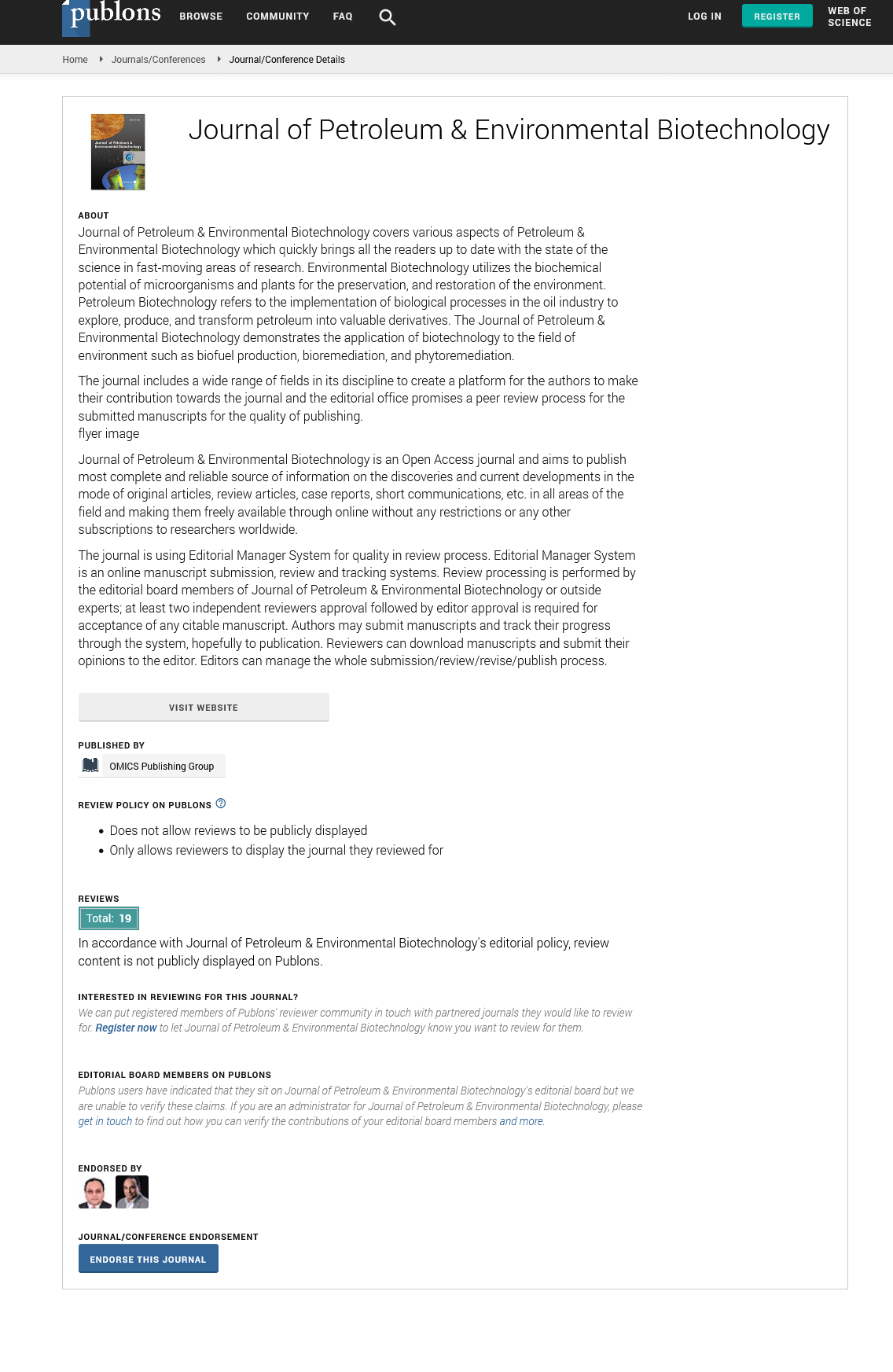Indexed In
- Open J Gate
- Genamics JournalSeek
- JournalTOCs
- China National Knowledge Infrastructure (CNKI)
- Electronic Journals Library
- RefSeek
- Hamdard University
- EBSCO A-Z
- OCLC- WorldCat
- SWB online catalog
- Virtual Library of Biology (vifabio)
- Publons
- MIAR
- Euro Pub
- Google Scholar
Useful Links
Share This Page
Journal Flyer

Open Access Journals
- Agri and Aquaculture
- Biochemistry
- Bioinformatics & Systems Biology
- Business & Management
- Chemistry
- Clinical Sciences
- Engineering
- Food & Nutrition
- General Science
- Genetics & Molecular Biology
- Immunology & Microbiology
- Medical Sciences
- Neuroscience & Psychology
- Nursing & Health Care
- Pharmaceutical Sciences
Opinion Article - (2025) Volume 16, Issue 1
Advances in Gasoline Technology and Environmental Mitigation
Zhen Wang*Received: 01-Mar-2025, Manuscript No. JPEB-25-29352; Editor assigned: 03-Mar-2025, Pre QC No. JPEB-25-29352 (PQ); Reviewed: 17-Mar-2025, QC No. JPEB-25-29352; Revised: 24-Mar-2025, Manuscript No. JPEB-25-29352 (R); Published: 31-Mar-2025, DOI: 10.35248/2157-7463.25.16.601
Description
Gasoline is one of the most widely used petroleum-derived fuels in the world, serving as a primary energy source for transportation. Derived from crude oil through the process of fractional distillation, gasoline is a complex mixture of hydrocarbons, primarily in the C4 to C12 range, including alkanes, cycloalkanes, and aromatic compounds. Its importance in global economies cannot be overstated, as it powers millions of vehicles daily and plays a key role in industrial and commercial operations.
The production of gasoline involves several refining processes beyond simple distillation. Catalytic cracking, hydrocracking, and reforming are employed to optimize yield and enhance octane ratings. High octane values are essential for preventing engine knocking, which is caused by the premature ignition of fuel in internal combustion engines. Additives are also incorporated into gasoline to improve performance, reduce emissions, and protect engine components. These include detergents, antioxidants, metal deactivators, and oxygenates like ethanol.
Ethanol blending has become increasingly common, particularly in countries aiming to reduce greenhouse gas emissions and dependence on fossil fuels. In many regions, gasoline is sold as E10 or E15, indicating a 10% or 15% ethanol blend, respectively. Ethanol not only increases the octane rating but also burns cleaner than pure gasoline. However, ethanol's hygroscopic nature and corrosive tendencies raise concerns regarding engine compatibility and fuel system integrity, especially in older vehicles.
The environmental impact of gasoline is a critical subject of study and concern. Combustion of gasoline releases significant quantities of Carbon Dioxide (CO2), a major contributor to global warming. Additionally, incomplete combustion can result in the emission of Carbon Monoxide (CO), unburned hydrocarbons, and Nitrogen Oxides (NOx), all of which are harmful to human health and contribute to urban smog and acid rain. The refining process itself is energy-intensive and generates a substantial carbon footprint. Spills and leaks during storage or transportation of gasoline can contaminate soil and groundwater, further complicating environmental remediation efforts.
Efforts to reduce the ecological footprint of gasoline have led to innovations in fuel formulation and engine design. Cleaner-burning gasoline formulations and stricter regulatory standards have significantly lowered the emission of harmful pollutants in many industrialized countries. Catalytic converters and direct fuel injection systems are examples of technological improvements that enhance fuel efficiency and reduce emissions. Regulatory frameworks such as the U.S. Clean Air Act and the European Union’s fuel quality directives have been instrumental in enforcing environmental compliance and stimulating research into alternative fuels.
Despite these advancements, the transition away from gasoline remains a long-term goal for many governments and environmental organizations. The rise of Electric Vehicles (EVs), supported by advancements in battery technology and renewable energy generation, is expected to gradually reduce global gasoline demand. Nevertheless, gasoline remains deeply entrenched in transportation infrastructure, particularly in regions lacking the economic means or technical capacity to switch rapidly to alternatives.
In conclusion, gasoline continues to be a foundation of modern energy systems, though it poses considerable environmental challenges. Its role in transportation, its economic significance, and its environmental implications make it a topic of central importance in both petroleum engineering and environmental biotechnology. As global priorities shift toward sustainability and carbon neutrality, the scientific community must explore innovative solutions that balance energy needs with ecological preservation.
Citation: Wang Z (2025) Advances in Gasoline Technology and Environmental Mitigation. J Pet Environ Biotechnol. 16:601.
Copyright: © 2025 Wang Z. This is an open access article distributed under the terms of the Creative Commons Attribution License, which permits unrestricted use, distribution, and reproduction in any medium, provided the original author and source are credited.

